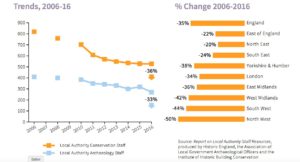The IHBC has welcomed the release of England’s new suite of heritage indicators by  Historic England, the final part of its Heritage Counts programme for 2016, with the theme for this year focussing on heritage branding of places.
Historic England, the final part of its Heritage Counts programme for 2016, with the theme for this year focussing on heritage branding of places.
James Caird, IHBC Chair said: ‘We welcome Heritage Counts and recommend it as an important resource for understanding the value of conservation and the benefits it provides for the economy and the community.’
‘Alongside the general review of the heritage sector, Heritage Counts includes a variety of statistical data on the heritage sector, local authority operations and public participation in heritage.’
‘This year it has been formatted in separate booklets on different aspects to make relevant information easier to pin down.’
Heritage Counts writes:
All the products from Heritage Counts 2016 have now been released!…
Placemaking and Heritage Research
This year, research for Heritage Counts focused on placemaking and heritage. To investigate this topic, research was conducted into the use of heritage in place branding by Business Improvement Districts. The findings of this project will appeal to all organisations involved with place branding and with an interest in how heritage could be incorporated to enhance places.
Visit here to access the research summary and main research report.
Annual update on the heritage sector
Alongside this new research is the annual overview of developments in the historic environment in 2016. Visit here to check it out!
2016 has been an important year for the heritage sector and has witnessed several important developments including:
- The publication of the Government’s Culture White Paper – the first comprehensive government strategy for the sector in over 50 years, and the first of its kind to reflect the value of all the cultural sectors.
- The formal launch of the Heritage 2020 framework.
- The first anniversary of the restructuring of English Heritage into Historic England and The English Heritage Trust.
- On-going reforms to both legislation and policy within the planning sector.
- The decision to leave the EU and the unknown effects upon the heritage sector.
- The appointment of Karen Bradley as the new Secretary of State for Culture, Media and Sport.
- Continued participation in the heritage sector through – the launch of the Enriching the List project, the Discover England Fund, and the Great Place Scheme. 3.4 million people also took part in Heritage Open Days, and over 120,000 children benefited from the Heritage Schools programme.
Heritage Indicators
Like previous years, we have collated key statistics which provide an insight into the state of the historic environment. In most cases, these statistics have been collected since 2002, providing a rich source of trend data. Click here to find the summary and to access the detailed five indicator spreadsheets.
Key headline findings include:
- Participation in heritage is becoming more inclusive, particularly among those living in the most deprived areas.
- Historic properties continue to attract large numbers of visitors.
- Membership to heritage organisations has grown considerably in the past year.
- Listed Building Consent applications are an increasing proportion of all applications submitted to planning authorities.
- Local Authority historic environment staff capacity continues to decline.
- There are nearly 400,000 designated heritage assets in England.
Local Authority Profiles
Started in 2014, local authority profiles provide comprehensive datasets and information on the historic environment for each individual local authority in England. Click here to access the workbook!
Heritage and Society 2016
This year, we produced a new document, Heritage and Society, which presents facts and figures which illustrate the benefits the historic environment brings to society. Visit here to check it out!
Heritage and the Economy 2016 and Heritage Economic Impact Indicator Workbook
We also updated the Heritage and the Economy document to present key facts and figures on the economic benefits of heritage. Visit here to explore the document!
Key findings include:
- Heritage generates an estimated £21.7 billion in Gross Added Value (GVA), which equates to 2% of national GVA.
- In total, domestic and international heritage-related visits generated £18.4bn in expenditure in England.
- There are an estimated 328,700 heritage jobs in England. That is 1% of total national employment.
- Repair and maintenance of historic buildings directly generated £9.7bn in construction sector output. This is equivalent to 8%of total construction output or 22 per cent of the repair and maintenance output.
The document also introduces new research: the Heritage Economic Impact Indicator Workbook 2016. The workbook, which will be updated annually, presents national and regional data on Heritage Gross Added Value, Tourism, Employment, and Construction output.
The workbook and technical note can be found here.
For more details follow the links from HE’s website
